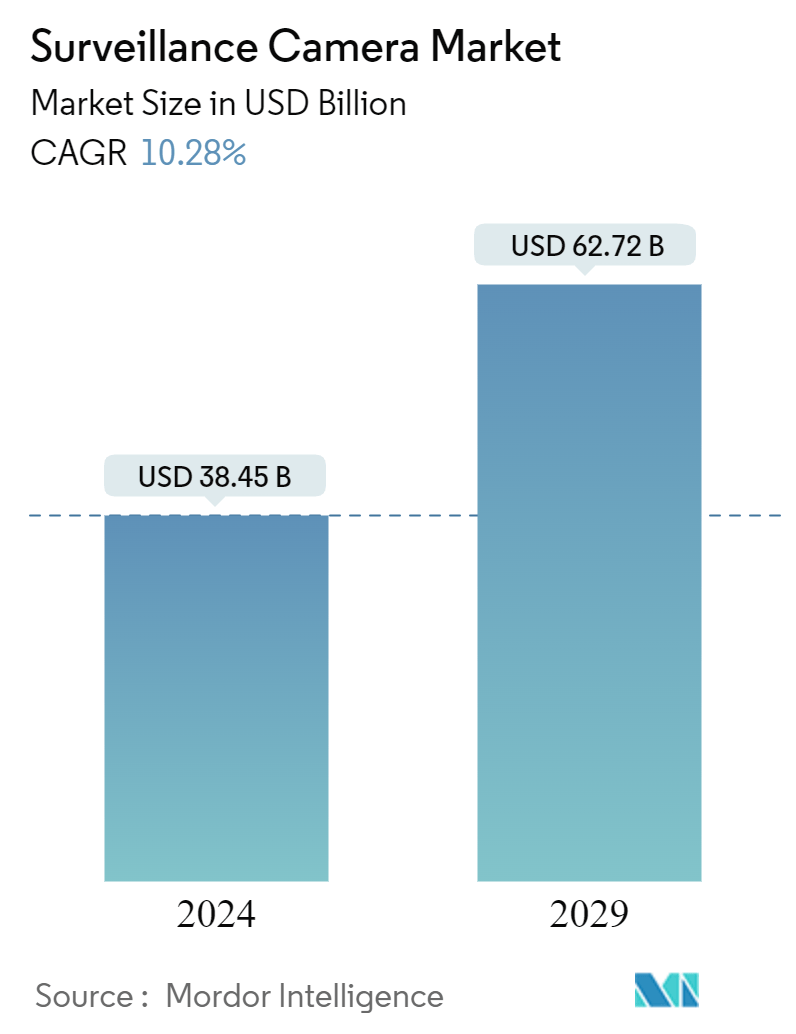Market Size of Surveillance Camera Industry

| Study Period | 2019 - 2029 |
| Market Size (2024) | USD 38.45 Billion |
| Market Size (2029) | USD 62.72 Billion |
| CAGR (2024 - 2029) | 10.28 % |
| Fastest Growing Market | Asia Pacific |
| Largest Market | North America |
Major Players
*Disclaimer: Major Players sorted in no particular order |
Surveillance Camera Market Analysis
The Surveillance Camera Market size is estimated at USD 38.45 billion in 2024, and is expected to reach USD 62.72 billion by 2029, growing at a CAGR of 10.28% during the forecast period (2024-2029).
Surveillance cameras are systems designed to capture video footage and even audio, sometimes that can either be monitored in real-time or recorded for later review. These cameras are often connected to a network, allowing authorized individuals to access the footage remotely.
- The development of digital technology and the increasing use of IP-based surveillance cameras are contributing to the growth of this market. IP cameras have rapidly become the go-to solution for video surveillance, bringing with them a range of advantages, including enhanced digital image quality, video analytics, and neuro-network capabilities. Since IP cameras transmit digital signals in real time, they provide enhanced video detail, making them ideal for facial and license plate recognition.
- The surveillance camera market has experienced a significant transformation in the past decade due to the rapid growth of cloud computing and video surveillance software development. Additionally, the increasing awareness of public safety and security issues has led to a surge in tadoptingIP cameras and video management systems.
- The decrease in IP camera prices and the development of advanced analytics and software like video surveillance as a service (VaaS) have increased the demand for wireless and spy cameras to protect citizens. The surveillance camera market is projected to expand due to the development of advanced IP-based digital solutions to detect and deter criminal activities, including vandalism, theft, and acts of terrorism. These factors are the primary drivers of the growth in the surveillance camera market.
- Implementing surveillance and analytics systems presents enterprise organizations with significant operational challenges, with accuracy being one of the primary barriers to adoption. Consumers' increasing data privacy concerns are hindering the growth of the surveillance camera market. Not only are customers deterred from adopting such solutions, but governments globally are legislating data usage and limiting data storage. As a result, enterprises need help creating datasets and expanding their offerings.
- The surveillance camera market witnessed a moderate impact of the pandemic and a steady recovery, with customers transitioning from video cameras to IP video camera systems. The growth in awareness and the pandemic-led awareness created among tonsumers about the benefits of digital technologies continues to impact the studied market's growth,positively, as consumers are now more open to investing in digital technologies, creating a ffavourableecosystem for the studied market's growth.

